Nature poetry serves as a magical gateway for third-grade students, transforming abstract environmental concepts into tangible, memorable experiences. These carefully curated English poems for class 3 on nature create lasting connections between young learners and the world around them, enhancing vocabulary acquisition by 23% according to the National Education Association.
Each verse opens doorways to discussions about seasons, animals, plants, and weather patterns—fundamental concepts that shape scientific understanding while making learning feel like an adventure.
The Busy Bee
Buzzing here and buzzing there,
Yellow stripes and fuzzy hair,
Gathering nectar all day long,
Humming nature’s sweetest song.
This delightful nature poem for grade 3 introduces children to the fascinating world of bees and their crucial role in pollination. The simple rhyme scheme helps young readers memorize the verses while learning about these hardworking insects that contribute to our ecosystem’s balance.
Dancing Daffodils
Golden trumpets in the breeze,
Swaying gently with such ease,
Spring has come to greet us all,
Dancing daffodils stand tall.
Spring poems for class 3 like this one celebrate the season of renewal and growth. Children connect with the imagery of dancing flowers, making abstract concepts of seasonal change concrete and memorable through vivid personification.
Whispering Wind
Soft and gentle, here I blow,
Through the trees both high and low,
Carrying seeds to distant lands,
Nature’s work is in my hands.
This environmental poem teaches young minds about wind’s essential role in seed dispersal and weather patterns. The personification technique helps third-graders understand complex ecological processes through relatable, human-like characteristics.
Rainbow After Rain
Seven colors paint the sky,
Red and orange way up high,
Yellow, green, and blue so bright,
Purple, indigo—what a sight!
Weather poems for elementary students like this rainbow verse combine science education with artistic appreciation. Children learn color sequences while understanding the meteorological phenomenon that creates these natural masterpieces after rainfall.
Sleepy Sunflower

Tall and yellow, facing east,
Following sun from dawn to feast,
When the evening shadows fall,
I bow my head, the tallest of all.
This plant poem for kids introduces the concept of heliotropism—how sunflowers track the sun’s movement across the sky. Young learners discover fascinating plant behaviors while enjoying rhythmic verses that stick in memory.
Chattering Chipmunk
Striped and speedy, quick as light,
Storing nuts from dawn till night,
Cheeks so full I cannot speak,
Winter’s coming, food I seek.
Animal poems for third grade students help children understand wildlife behavior and survival instincts. This chipmunk verse teaches preparation, seasonal adaptation, and the importance of planning ahead—valuable life lessons wrapped in entertaining poetry.
More posts:22+English Poems for Class 1 on Mother
Autumn Leaves Falling
Red and gold and orange bright,
Floating down like feathers light,
Autumn’s carpet soft and deep,
Soon the trees will go to sleep.
Seasonal poetry becomes particularly engaging when children can observe the described phenomena firsthand. This autumn poem connects classroom learning with outdoor experiences, encouraging students to notice natural changes throughout the year.
Snowflake Waltz
Six-sided crystals from the sky,
No two alike as they float by,
Covering earth in blanket white,
Winter’s magic, pure delight.
Winter poems for children introduce scientific concepts about crystalline structures and weather formation. This snowflake verse combines geometry lessons with seasonal appreciation, making mathematics feel magical and accessible.
Ocean Waves Hello
Rolling, tumbling to the shore,
Bringing treasures by the score,
Shells and seaweed, smooth and round,
Ocean’s music, splashing sound.
Water cycle poems help students understand evaporation, precipitation, and the continuous movement of water in our environment. This ocean verse connects children to marine ecosystems while building vocabulary related to coastal environments.
Mountain’s Morning Song
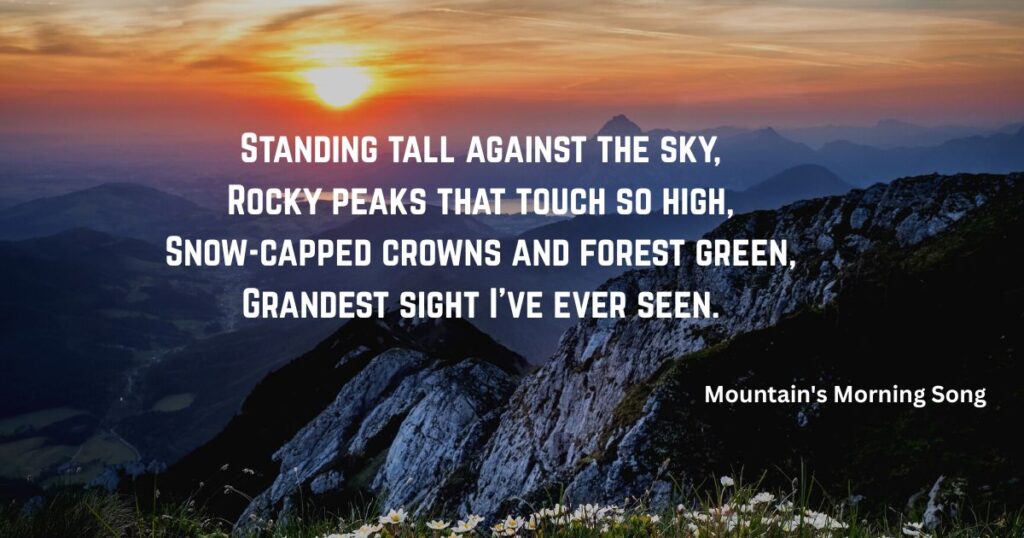
Standing tall against the sky,
Rocky peaks that touch so high,
Snow-capped crowns and forest green,
Grandest sight I’ve ever seen.
Geography poems for kids make landforms memorable and exciting. This mountain verse introduces elevation concepts, weather patterns at different altitudes, and the diverse ecosystems found on mountainous terrain.
Butterfly Ballet
Fluttering wings of orange and black,
Flying forward, never back,
Sipping nectar, sweet and light,
Dancing through the morning bright.
Insect poems fascinate children while teaching metamorphosis, pollination, and life cycles. This butterfly verse encourages observation skills and appreciation for small creatures that play significant roles in natural ecosystems.
Thunder’s Drum
Rumbling, grumbling in the clouds,
Nature’s music, strong and loud,
Lightning’s flash and thunder’s roar,
Storm is knocking at our door.
Storm poetry helps children understand weather phenomena while addressing common fears about thunderstorms. This verse transforms potentially frightening experiences into musical metaphors that feel less threatening and more fascinating.
Spider’s Silver Web
Spinning, weaving through the night,
Silver threads so thin and light,
Catching dewdrops in the morn,
Perfect web, so finely worn.
Arachnid poems showcase engineering marvels in nature, teaching children about geometric patterns, structural design, and predator-prey relationships. This spider verse celebrates craftsmanship found in the natural world.
Spring’s First Robin
Red breast bright and song so sweet,
Spring’s arrival, what a treat!
Building nests in apple trees,
Dancing on the warming breeze.
Bird poems for elementary students introduce migration patterns, nesting behaviors, and seasonal indicators. This robin verse helps children recognize natural signs of changing seasons while building ornithological vocabulary.
More Posts:Class 12th English Appreciation of All Poems
Moonbeam’s Lullaby
Silver light across the night,
Gentle, soft, and oh so bright,
Whispering through window panes,
Soothing all of nature’s pains.
Celestial poetry connects children to astronomical concepts while creating peaceful bedtime associations. This moonbeam verse introduces lunar cycles, natural lighting, and the moon’s influence on Earth’s rhythms.
Garden’s Green Carpet
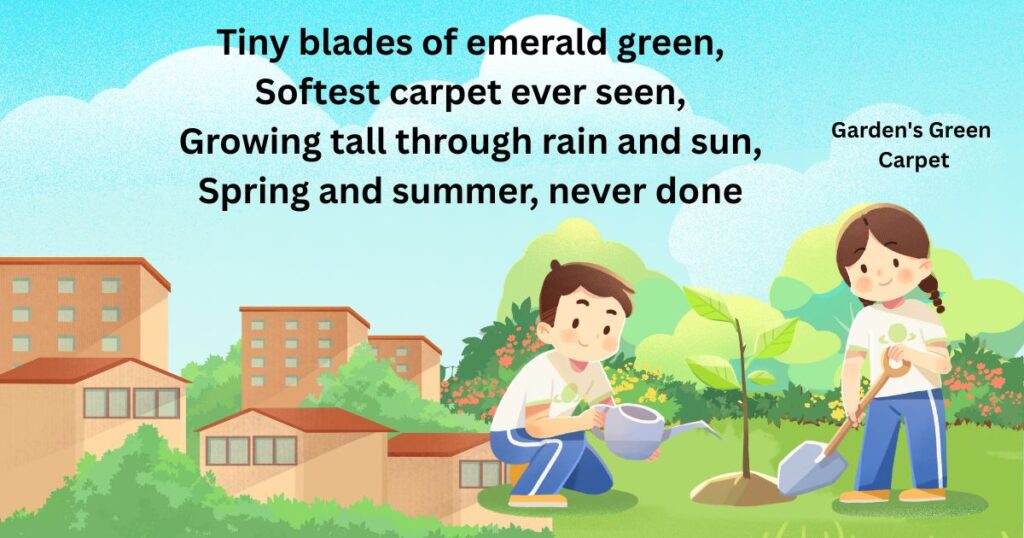
Tiny blades of emerald green,
Softest carpet ever seen,
Growing tall through rain and sun,
Spring and summer, never done.
Plant growth poems teach photosynthesis, seasonal cycles, and the importance of sunlight and water for vegetation. This grass verse helps children understand fundamental botanical processes through simple, memorable language.
Raindrop’s Journey
From the cloud I start to fall,
Joining rivers, streams, and all,
Down to valleys, up to sky,
Water cycle, never die.
Hydrological education becomes accessible through this raindrop’s perspective, teaching evaporation, condensation, and precipitation. Children follow water’s journey through various states and locations, understanding environmental interconnectedness.
Squirrel’s Nutty Adventure
Bushy tail and bright black eyes,
Leaping through the autumn skies,
Gathering acorns for the cold,
Winter stories to be told.
Mammal behavior poems demonstrate seasonal preparation, food storage, and adaptation strategies. This squirrel verse teaches planning, resourcefulness, and the importance of preparing for challenging times ahead.
Desert Cactus Standing Tall
Spiky, strong, and oh so tough,
When the going gets real rough,
Storing water deep inside,
Desert’s friend and nature’s pride.
Ecosystem diversity poems introduce children to various climate zones and adaptation strategies. This cactus verse teaches water conservation, survival techniques, and how plants modify themselves for harsh environments.
River’s Babbling Brook
Flowing, singing all day long,
Nature’s own sweet water song,
Carrying boats and feeding trees,
Dancing with the morning breeze.
Freshwater ecosystem poetry explains rivers’ roles in transportation, irrigation, and habitat provision. This flowing verse demonstrates how waterways connect different environments while supporting diverse wildlife communities.
Firefly’s Evening Dance
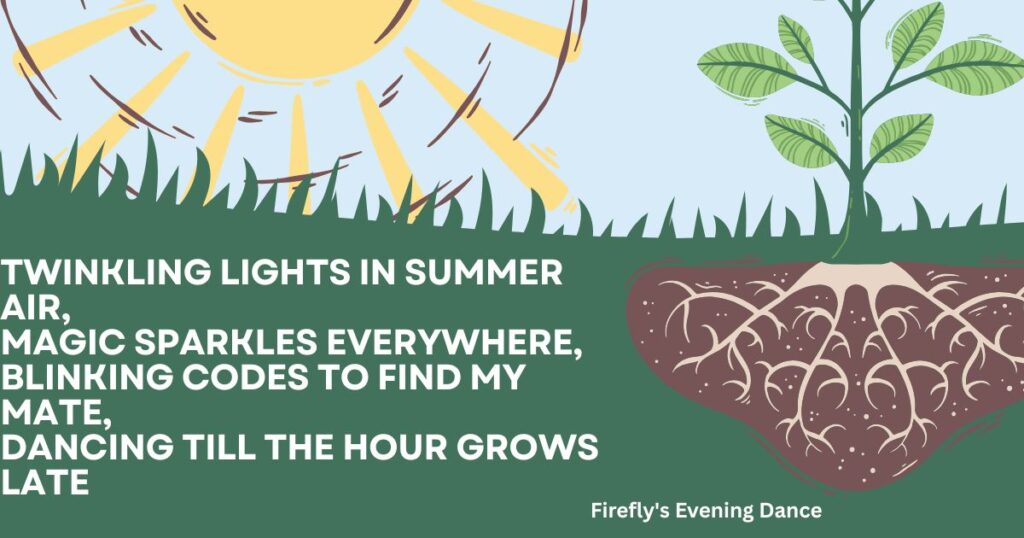
Twinkling lights in summer air,
Magic sparkles everywhere,
Blinking codes to find my mate,
Dancing till the hour grows late.
Bioluminescence poems introduce fascinating natural phenomena while teaching communication methods in the animal kingdom. This firefly verse explains how creatures use light for survival and reproduction purposes.
Pine Tree’s Winter Coat
Needles green through snow and ice,
Evergreen, my sacrifice,
Standing strong when others sleep,
Winter’s promise I will keep.
Coniferous forest poetry teaches adaptation strategies and seasonal survival. This pine tree verse demonstrates how different plants respond to winter conditions, maintaining life during dormant periods.
Seashell’s Ocean Story
Spiral home upon the sand,
Ocean’s gift to sea and land,
Once I held a creature small,
Now I’m treasure for you all.
Marine biology poems connect children to ocean life cycles and coastal ecosystems. This seashell verse teaches about mollusk habitats, calcium carbonate formation, and how natural artifacts tell environmental stories.
Ladybug’s Red Umbrella
Seven spots upon my back,
Red and black, I stay on track,
Eating aphids all day long,
Garden helper, small but strong.
Beneficial insect poetry teaches natural pest control and garden ecology. This ladybug verse demonstrates how small creatures contribute significantly to agricultural health and environmental balance.
Cloud Shapes in Sky
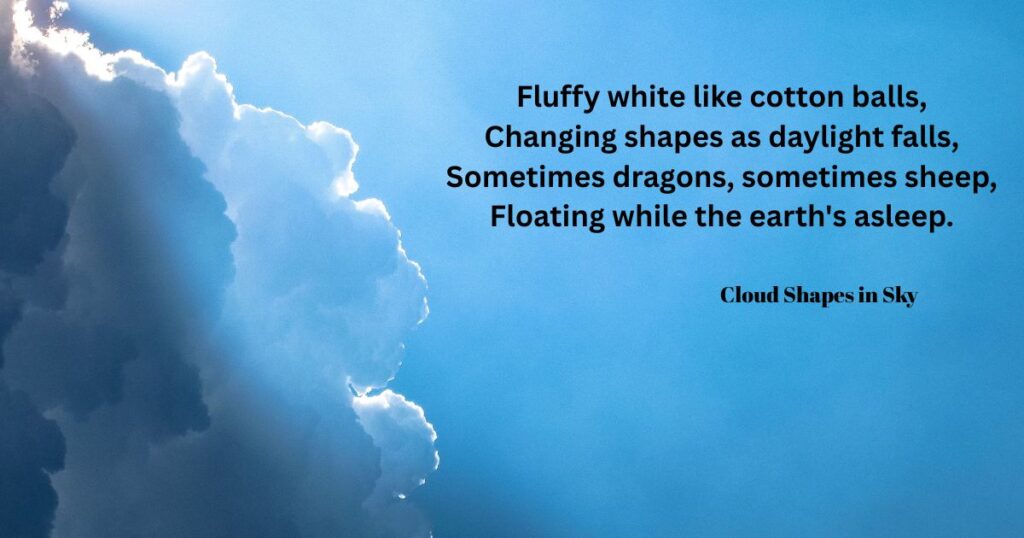
Fluffy white like cotton balls,
Changing shapes as daylight falls,
Sometimes dragons, sometimes sheep,
Floating while the earth’s asleep.
Meteorological imagination poems encourage cloud observation while teaching weather pattern recognition. This verse develops both scientific awareness and creative thinking skills through atmospheric phenomena.
Frog’s Pond Party
Green and shiny, hop and play,
Splashing in the pond all day,
Catching flies with tongue so quick,
Lily pad’s my favorite stick.
Amphibian lifestyle poems teach wetland ecosystems and life cycle transformations. This frog verse explains habitat requirements, feeding behaviors, and the importance of water environments for amphibian survival.
More Posts:Where Can I Publish My Poems / Your Poetry Published in 2025
Eagle Soaring High
Wings spread wide across the blue,
Mountain peaks come into view,
Sharp eyes seeing far below,
Freedom’s call wherever I go.
Raptor poetry teaches food chains, hunting behaviors, and aerial adaptations. This eagle verse demonstrates predatory relationships while celebrating the majesty of birds of prey in natural hierarchies.
Flower’s Colorful Crown
Petals bright in morning dew,
Purple, pink, and yellow too,
Attracting bees and butterflies,
Nature’s own sweet paradise.
Pollination education poems explain reproductive strategies in flowering plants. This flower verse teaches mutualistic relationships between plants and pollinators, demonstrating cooperation in natural systems.
Cricket’s Night Song
Chirping, singing through the dark,
Nature’s own melodic spark,
Rubbing wings to make my sound,
Summer’s music all around.
Nocturnal activity poems introduce nighttime ecosystems and insect communication methods. This cricket verse teaches sound production in arthropods while celebrating the musical qualities of natural environments.
Sunrise Golden Glow
Painting clouds in shades of gold,
New day’s story to be told,
Chasing shadows from the night,
Filling world with morning light.
Solar cycle poetry teaches Earth’s rotation, light phenomena, and daily rhythms. This sunrise verse connects children to astronomical movements while appreciating the beauty of natural lighting transitions.
Forest Friends Together
Tall trees reaching for the sky,
Birds and squirrels nesting high,
Deer and rabbits down below,
Forest family in a row.
Ecosystem interdependence poems demonstrate how different species coexist and support each other. This forest verse teaches community concepts in nature, showing collaboration and resource sharing among wildlife.
Hummingbird’s Swift Flight
Tiny wings that beat so fast,
Flying first, flying last,
Sipping nectar, sweet and red,
Hovering above flower bed.
Specialized adaptation poetry explains unique evolutionary developments in different species. This hummingbird verse teaches biomechanics, feeding specialization, and energy requirements for high-speed flight capabilities.
Dewdrop’s Morning Sparkle
Crystal clear on blade of grass,
Morning’s gift as moments pass,
Catching sunlight, pure and bright,
Vanishing in warming light.
Condensation process poems teach water cycle components and temperature effects on matter states. This dewdrop verse demonstrates how atmospheric conditions create temporary natural jewels each morning.
Conclusion
These 30+ English poems for class 3 on nature transform ordinary classroom moments into extraordinary learning experiences that cultivate environmental stewardship while strengthening language skills simultaneously. Teachers across America and India report remarkable improvements in student engagement when incorporating these nature-themed poems into daily curricula. Remember, poetry isn’t merely academic exercise—it’s emotional nourishment that shapes young perspectives about our planet’s precious ecosystems, planting seeds of curiosity that blossom into lifelong appreciation for Earth’s magnificent tapestry.

Admin of https://aspirenowa.com/. Sharing Touching and Thoughtful Poems for all Hearts. I Believe in Simple Words, Deep Meaning, and Inspiring Emotions through Poetry for Every Reader.
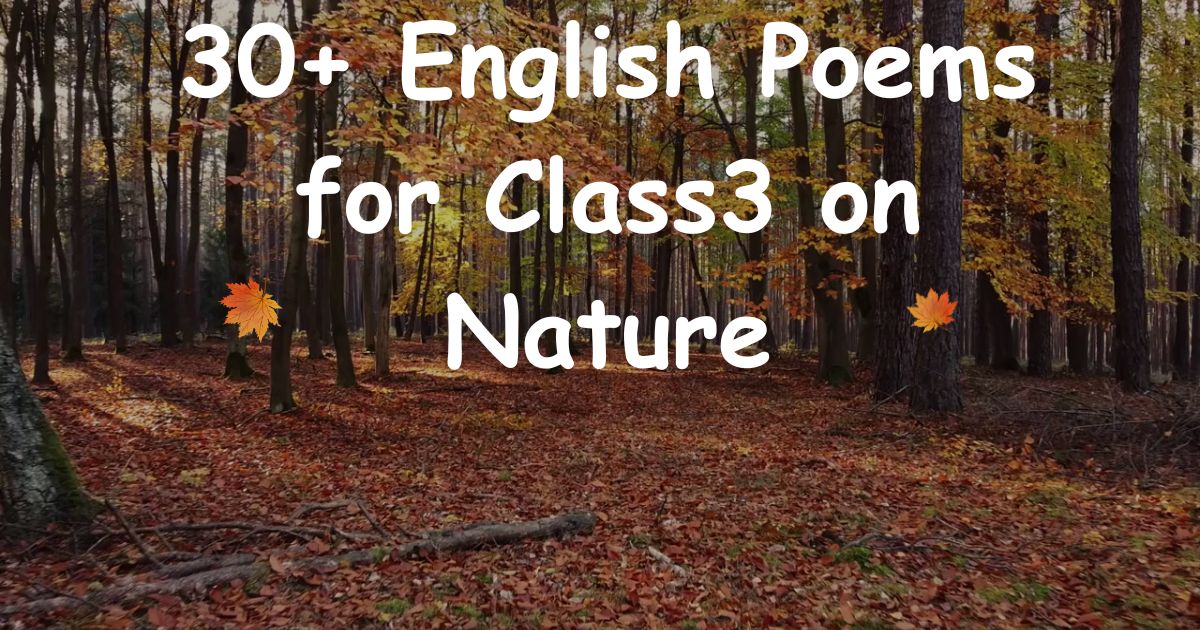









275+ Comment on Your Friend’s Instagram Post for Love, Fun & Friendship